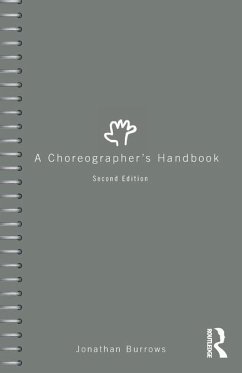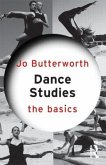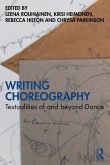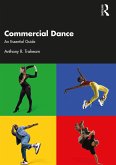Jonathan Burrows
A Choreographer's Handbook
Jonathan Burrows
A Choreographer's Handbook
- Broschiertes Buch
- Merkliste
- Auf die Merkliste
- Bewerten Bewerten
- Teilen
- Produkt teilen
- Produkterinnerung
- Produkterinnerung
The updated and revised edition of A Choreographerâ s Handbook invites readers to investigate how and why to make a dance performance. Burrowsâ open and honest prose gives the reader access to a range of principles, exercises, meditations and ideas on choreography that allow artists and dance-makers to find their own aesthetic process.
Andere Kunden interessierten sich auch für
![The Art of Dance Composition The Art of Dance Composition]() Jenefer DaviesThe Art of Dance Composition60,99 €
Jenefer DaviesThe Art of Dance Composition60,99 €![Dance Studies Dance Studies]() Jo Butterworth (Malta University of Malta)Dance Studies29,99 €
Jo Butterworth (Malta University of Malta)Dance Studies29,99 €![You, the Choreographer You, the Choreographer]() Vladimir AngelovYou, the Choreographer84,99 €
Vladimir AngelovYou, the Choreographer84,99 €![Writing Choreography Writing Choreography]() Writing Choreography49,99 €
Writing Choreography49,99 €![Commercial Dance Commercial Dance]() Anthony R. TrahearnCommercial Dance58,99 €
Anthony R. TrahearnCommercial Dance58,99 €![Undergraduate Research in Dance Undergraduate Research in Dance]() Lynnette Young Overby (USA University of Delaware)Undergraduate Research in Dance51,99 €
Lynnette Young Overby (USA University of Delaware)Undergraduate Research in Dance51,99 €![Choreographing Dirt Choreographing Dirt]() Angenette SpalinkChoreographing Dirt65,99 €
Angenette SpalinkChoreographing Dirt65,99 €-
-
-
The updated and revised edition of A Choreographerâ s Handbook invites readers to investigate how and why to make a dance performance. Burrowsâ open and honest prose gives the reader access to a range of principles, exercises, meditations and ideas on choreography that allow artists and dance-makers to find their own aesthetic process.
Produktdetails
- Produktdetails
- Verlag: Taylor & Francis Ltd
- 2 ed
- Seitenzahl: 272
- Erscheinungstermin: 25. November 2024
- Englisch
- Abmessung: 198mm x 129mm x 15mm
- Gewicht: 288g
- ISBN-13: 9781032629018
- ISBN-10: 1032629010
- Artikelnr.: 70734766
- Herstellerkennzeichnung
- Libri GmbH
- Europaallee 1
- 36244 Bad Hersfeld
- gpsr@libri.de
- Verlag: Taylor & Francis Ltd
- 2 ed
- Seitenzahl: 272
- Erscheinungstermin: 25. November 2024
- Englisch
- Abmessung: 198mm x 129mm x 15mm
- Gewicht: 288g
- ISBN-13: 9781032629018
- ISBN-10: 1032629010
- Artikelnr.: 70734766
- Herstellerkennzeichnung
- Libri GmbH
- Europaallee 1
- 36244 Bad Hersfeld
- gpsr@libri.de
Jonathan Burrows is a choreographer, teacher and writer, whose work has been invited widely internationally. He is best known for an ongoing body of work with the composer Matteo Fargion, with whom he has collaborated for over 30 years. He is the author of 'A Choreographer's Handbook' (Routledge 2010) and 'Writing Dance' (2022) and is currently Associate Professor at the Centre for Dance Research, Coventry University, UK.
Preface, 2nd edition Dancing
Principles Material Habits Repetition Repetition Repetition Improvisation
Cut and paste
Choreography Form Exploration
Risk Breaking the rules Subject
Inspiration
Stealing
Familiar movement
Choreography
Referencing other sources Research
How and what?
Dramaturgy
Theory
Curiosity Contract
Performance space Self-expression Abstract dance Interview
Unfinished business
Questions
Principles Financial limitations
Studios
Funding applications Collaboration
Audience Preparation
Meetings
Rehearsal schedule
Heaviness Originality
Ecology
Paradox Technique
Parrot on your shoulder
Authenticity
Dancing
Style
Fiddling Virtuosity Specificity Daily practice Hoarding
Beginnings Endings Keeping it going
Pacing Change
Dub reggae
Simple material
Desperation Predictable and unpredictable
Expectation Stillness and silence Minimal and maximal Solos, duos, trios, quartets Many bodies
States Parallel Voices Performance
Principles Distracting the self
Paradox
Choreography
Performance
Electric guitars Does it work?
Showings
Mentoring Narrative
Ballet
Continuity Continuity
Material
Make six things
Choreography
Flow Relation Relation
Time
Rhythm Time Counterpoint Unison Scores
Studios
Translation
Sequencing
Improvisation Chance
Empty hands
Gamut of movements
Limitations
Laborious work
Philosophy Audience
Facing the front
Facing each other
Confrontation
Humour
Failure Place or space? Audience Hierarchies
Dancer or choreographer?
In it or out of it?
Who owns what? The marketplace
Earning a living
Administrating the work
Commercial work
Commissions
Academia Music
Collaboration
Silence Text Lighting
Technicians
Collaboration
Costumes
Set design
Nudity Filming
History
Collaboration
Mirrors
Human-scale Titles How can I simplify all of this? Forget all this
Principles Material Habits Repetition Repetition Repetition Improvisation
Cut and paste
Choreography Form Exploration
Risk Breaking the rules Subject
Inspiration
Stealing
Familiar movement
Choreography
Referencing other sources Research
How and what?
Dramaturgy
Theory
Curiosity Contract
Performance space Self-expression Abstract dance Interview
Unfinished business
Questions
Principles Financial limitations
Studios
Funding applications Collaboration
Audience Preparation
Meetings
Rehearsal schedule
Heaviness Originality
Ecology
Paradox Technique
Parrot on your shoulder
Authenticity
Dancing
Style
Fiddling Virtuosity Specificity Daily practice Hoarding
Beginnings Endings Keeping it going
Pacing Change
Dub reggae
Simple material
Desperation Predictable and unpredictable
Expectation Stillness and silence Minimal and maximal Solos, duos, trios, quartets Many bodies
States Parallel Voices Performance
Principles Distracting the self
Paradox
Choreography
Performance
Electric guitars Does it work?
Showings
Mentoring Narrative
Ballet
Continuity Continuity
Material
Make six things
Choreography
Flow Relation Relation
Time
Rhythm Time Counterpoint Unison Scores
Studios
Translation
Sequencing
Improvisation Chance
Empty hands
Gamut of movements
Limitations
Laborious work
Philosophy Audience
Facing the front
Facing each other
Confrontation
Humour
Failure Place or space? Audience Hierarchies
Dancer or choreographer?
In it or out of it?
Who owns what? The marketplace
Earning a living
Administrating the work
Commercial work
Commissions
Academia Music
Collaboration
Silence Text Lighting
Technicians
Collaboration
Costumes
Set design
Nudity Filming
History
Collaboration
Mirrors
Human-scale Titles How can I simplify all of this? Forget all this
Preface, 2nd edition Dancing
Principles Material Habits Repetition Repetition Repetition Improvisation
Cut and paste
Choreography Form Exploration
Risk Breaking the rules Subject
Inspiration
Stealing
Familiar movement
Choreography
Referencing other sources Research
How and what?
Dramaturgy
Theory
Curiosity Contract
Performance space Self-expression Abstract dance Interview
Unfinished business
Questions
Principles Financial limitations
Studios
Funding applications Collaboration
Audience Preparation
Meetings
Rehearsal schedule
Heaviness Originality
Ecology
Paradox Technique
Parrot on your shoulder
Authenticity
Dancing
Style
Fiddling Virtuosity Specificity Daily practice Hoarding
Beginnings Endings Keeping it going
Pacing Change
Dub reggae
Simple material
Desperation Predictable and unpredictable
Expectation Stillness and silence Minimal and maximal Solos, duos, trios, quartets Many bodies
States Parallel Voices Performance
Principles Distracting the self
Paradox
Choreography
Performance
Electric guitars Does it work?
Showings
Mentoring Narrative
Ballet
Continuity Continuity
Material
Make six things
Choreography
Flow Relation Relation
Time
Rhythm Time Counterpoint Unison Scores
Studios
Translation
Sequencing
Improvisation Chance
Empty hands
Gamut of movements
Limitations
Laborious work
Philosophy Audience
Facing the front
Facing each other
Confrontation
Humour
Failure Place or space? Audience Hierarchies
Dancer or choreographer?
In it or out of it?
Who owns what? The marketplace
Earning a living
Administrating the work
Commercial work
Commissions
Academia Music
Collaboration
Silence Text Lighting
Technicians
Collaboration
Costumes
Set design
Nudity Filming
History
Collaboration
Mirrors
Human-scale Titles How can I simplify all of this? Forget all this
Principles Material Habits Repetition Repetition Repetition Improvisation
Cut and paste
Choreography Form Exploration
Risk Breaking the rules Subject
Inspiration
Stealing
Familiar movement
Choreography
Referencing other sources Research
How and what?
Dramaturgy
Theory
Curiosity Contract
Performance space Self-expression Abstract dance Interview
Unfinished business
Questions
Principles Financial limitations
Studios
Funding applications Collaboration
Audience Preparation
Meetings
Rehearsal schedule
Heaviness Originality
Ecology
Paradox Technique
Parrot on your shoulder
Authenticity
Dancing
Style
Fiddling Virtuosity Specificity Daily practice Hoarding
Beginnings Endings Keeping it going
Pacing Change
Dub reggae
Simple material
Desperation Predictable and unpredictable
Expectation Stillness and silence Minimal and maximal Solos, duos, trios, quartets Many bodies
States Parallel Voices Performance
Principles Distracting the self
Paradox
Choreography
Performance
Electric guitars Does it work?
Showings
Mentoring Narrative
Ballet
Continuity Continuity
Material
Make six things
Choreography
Flow Relation Relation
Time
Rhythm Time Counterpoint Unison Scores
Studios
Translation
Sequencing
Improvisation Chance
Empty hands
Gamut of movements
Limitations
Laborious work
Philosophy Audience
Facing the front
Facing each other
Confrontation
Humour
Failure Place or space? Audience Hierarchies
Dancer or choreographer?
In it or out of it?
Who owns what? The marketplace
Earning a living
Administrating the work
Commercial work
Commissions
Academia Music
Collaboration
Silence Text Lighting
Technicians
Collaboration
Costumes
Set design
Nudity Filming
History
Collaboration
Mirrors
Human-scale Titles How can I simplify all of this? Forget all this








